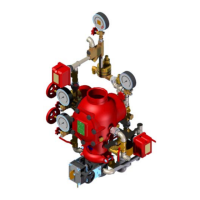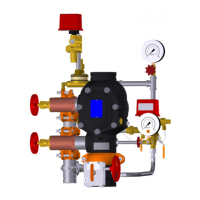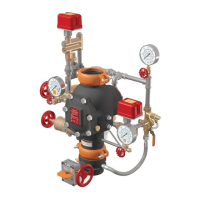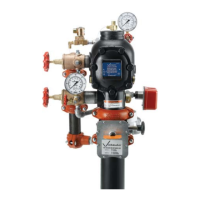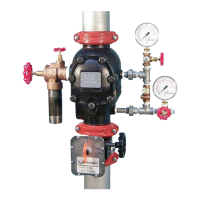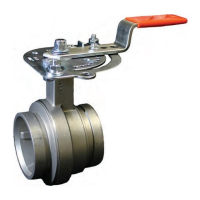TROUBLESHOOTING–SERIES776LOW-PRESSUREACTUATOR
Problem PossibleCause Solution
When the Auto Vent Sleeve of the Series 776 Low-Pressure Actua-
tor is pulled up, the screw does not stay set in the “UP” position.
The Series 776 Low-Pressure Actuator is not receiving enough air. Increase the air pressure going into the Series 776 Low-Pressure Actuator.
The Series 776 Low-Pressure Actuator has a broken seal. If the above procedure does not work, contact Victaulic.
Water is leaking through the Series 776 Low-Pressure Actuator. The air chamber of the Series 776 Low-Pressure Actuator is not set. Make sure the vent seal of the Series 776 Low-Pressure Actuator is in the set
position and the air chamber is pressurized.
The strainer on the Series 776 Low-Pressure Actuator is clogged. Replace the strainer screen of the Series 776 Low-Pressure Actuator. Refer
to the “Replacing the Strainer Screen for Series 776 Low-Pressure Actuators”
section.
The Series 776 Low-Pressure Actuator has a ripped diaphragm. If water still leaks through the Series 776 after performing the above
procedures, contact Victaulic.
No water is passing through the Series 776 Low-Pressure Actuator. The strainer on the diaphragm charge line is clogged. Disassemble and clean the diaphragm charge line strainer. Refer to the
applicable trim drawing for details.
TROUBLESHOOTING–SERIES746-LPADRYACCELERATOR
Problem PossibleCause Solution
The valve operates without sprinkler activation. There is a loss of air pressure in the lower inlet chamber of the Series Check for air loss at the lower chamber seal. If a leak is present, turn the
746-LPA Dry Accelerator. adjustment nut counterclockwise to seal.
Check for any leaks in the system and trim. Conrm that the AMTA is
operating properly.
The Series 746-LPA Dry Accelerator does not operate within a There is a loss of air pressure in the upper air chamber of the Series 746- Apply soapy water to all joints around the Series 746-LPA Dry Accelerator to
5-psi/34-kPa/0.3-Bar pressure drop in system air pressure. LPA Dry Accelerator. check for leaks. Repair any leaks and re-test.
The air decay rate of the system is too slow. Make sure there are no restrictions in the remote system test valve
(inspector’s test connection).
If the above procedures do not work, contact Victaulic.
The Series 746-LPA Dry Accelerator does not set up properly The Series 746-LPA Dry Accelerator is installed upside-down. Remove the Series 746-LPA Dry Accelerator from the trim, and turn the unit
(cannot get pressure on the upper gauge, and the button pops up around so that the vent seal “button” is facing down (toward the Series 776
immediately when pressure is introduced). Low-Pressure Actuator).
TROUBLESHOOTING–SYSTEM
Problem PossibleCause Solution
The valve operates without sprinkler activation. There is a loss of air pressure in the system or trim. Check for any leaks in the system and trim. Conrm that the AMTA is operat-
ing properly. Consider installing a low-air supervisory switch.
The pressure switch on the air compressor is set too low, or the compressor
is not operating properly.
Increase the “ON” setting of the air compressor’s pressure switch, and check
the air compressor for proper operation.
Water is leaking from the drip check located in the alarm line. Water is getting past the clapper seal and into the intermediate chamber
of the valve.
Check the clapper seal and valve body seat ring for physical damage and
foreign material.
Water is under the clapper seal. Inspect the clapper seal to make sure no water is under the seal. If water is
present, remove and replace the seal. Refer to the “Removing and Replacing
the Clapper Seal” section.
Air is leaking from the drip check located in the alarm line. Air is getting past the clapper seal and into the intermediate chamber of
the valve.
Check the clapper seal and valve body seat ring for physical damage and
foreign material.
Water is under the clapper seal. Inspect the clapper seal to make sure no water is under the seal. If water is
present, remove and replace the seal. Refer to the “Removing and Replacing
the Clapper Seal” section.
The clapper will not latch closed. There is no water pressure on the diaphragm. Check the water pressure in the diaphragm charge line. Make sure the
restrictor in the diaphragm charge line is clean.
The Auto Drain is not set. Set the Auto Drain by pulling up on the Auto Drain Sleeve.
Water is leaking from the diaphragm assembly. The diaphragm is damaged. Contact Victaulic.
Air is leaking from the diaphragm assembly. The diaphragm is damaged. Contact Victaulic.
I-768_39
FireLockNXT™DryValve
SERIES768
I-768INSTALLATION,MAINTENANCE,ANDTESTINGMANUAL
www.victaulic.com
VICTAULIC IS A REGISTERED TRADEMARK OF VICTAULIC COMPANY. © 2007 VICTAULIC COMPANY. ALL RIGHTS RESERVED. PRINTED IN THE USA.
REV_D
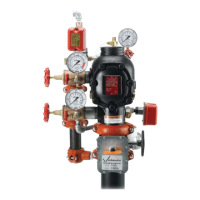
